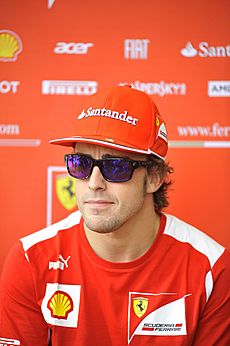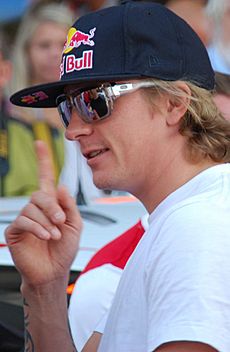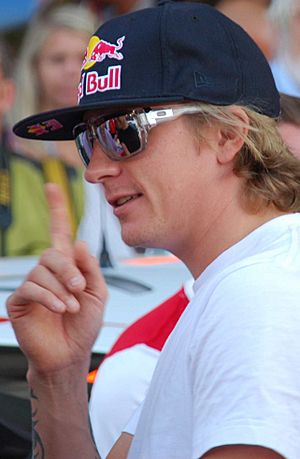2012 Formula One season facts for kids
The 2012 Formula One season was the 63rd year of the Formula One World Championship. This exciting season had twenty races, starting in Australia on March 18 and ending in Brazil on November 25. A big change for 2012 was the return of the United States Grand Prix, held at the Circuit of the Americas in Austin, Texas. Also, the Bahrain Grand Prix came back after being cancelled in 2011 due to civil protests.


The start of the season was very unpredictable! Seven different drivers won the first seven races, which was a new record for Formula One. It wasn't until the European Grand Prix in June that a driver, Ferrari's Fernando Alonso, won his second race of the year. Alonso led the championship for the next seven races. He won his third race in Germany and stood on the podium in the United Kingdom, Italy, and Singapore.
However, Alonso had to stop early in races in Belgium and Japan. This allowed his rivals to catch up. The defending World Champion, Sebastian Vettel, then took the lead in the sixteenth race of the season. Vettel also faced problems during the year. He finished outside the points in Malaysia after touching another car. Problems with his car's alternator in the European and Italian Grands Prix cost him valuable points. He also had to start from the pit lane in Abu Dhabi after a qualifying issue.
Vettel went into the final race of the season with a thirteen-point lead over Alonso. Alonso needed to finish in the top three to have a chance at winning the championship. But in a race that ended under the safety car, Vettel finished sixth. This gave him enough points to win his third championship in a row, making him only the third driver to do so! In the World Constructors' Championship, Red Bull Racing won their third title in a row when Sebastian Vettel finished second at the United States Grand Prix.
Besides the seven different winners at the start, 2012 also had the most races ever in a season with twenty. This beat the old record of nineteen, which was set in 2005. Six current or former World Drivers' Champions started the season: Sebastian Vettel, Fernando Alonso, Jenson Button, Lewis Hamilton, Kimi Räikkönen, and Michael Schumacher. This broke the record of five champions set in 1970.
Contents
Pre-Season Testing
Before the season began, teams tested their new cars. The pre-season testing started right after the 2011 Abu Dhabi Grand Prix. There was a three-day 'Young Driver Test' for new drivers at the Yas Marina Circuit in November 2011. Toro Rosso test driver Jean-Éric Vergne was the fastest driver in every session, driving for Red Bull Racing.
This test also showed off Pirelli's new tires for 2012. Almost all the tire types used in 2011 were changed a lot. Some teams, like Williams and Mercedes, used these tests to try out new parts for 2012. This was important because there was a ban coming on a special car part called "exhaust-blown diffusers."
Teams and Drivers for 2012
After a disagreement between the Formula One Teams Association and the FIA in 2009, a new agreement was signed. This agreement, called the Concorde Agreement, was valid until the end of 2012.
The FIA released a list of all the teams and drivers for 2012 on November 30, 2011.
Team Name Changes
- In June 2011, Williams announced they would use Renault engines for 2012 and 2013. Renault had powered Williams to many championships before.
- Virgin Racing changed their technical approach and partnered with McLaren.
- Force India got a new owner, the Sahara Group, and became "Sahara Force India F1 Team."
- Several teams changed their names for 2012:
* Team Lotus became Caterham F1 Team. * Lotus Renault GP became Lotus F1 Team. * Virgin Racing became Marussia F1 Team.
- The old dispute over the "Lotus" name was finally settled.
- Mercedes GP changed its official team name to Mercedes AMG.
- HRT moved its headquarters to Spain and got a new team boss, Luis Pérez-Sala.
Driver Lineup Changes

- Jaime Alguersuari and Sébastien Buemi left Scuderia Toro Rosso. Buemi became a test driver for Red Bull Racing.
- Jérôme d'Ambrosio left Virgin Racing.
- Rubens Barrichello left Williams and didn't have a race seat for 2012.
- Pedro de la Rosa returned to Formula One with HRT after being a test driver.
- Romain Grosjean, the 2011 GP2 Series champion, returned to Formula One with Lotus F1.
- Nico Hülkenberg returned to Formula One with Force India after being their test driver.
- Robert Kubica was still recovering from a rally accident and couldn't start the 2012 season.
- Vitaly Petrov left Lotus F1.
- Charles Pic joined Marussia.
- Kimi Räikkönen, the 2007 World Champion, returned to F1 with Lotus F1 Team after two years in rallying.
- Daniel Ricciardo moved from HRT to Toro Rosso.
- Bruno Senna joined Williams.
- Adrian Sutil left Force India.
- Jean-Éric Vergne filled Toro Rosso's second racing seat.
2012 Race Calendar
Formula One boss Bernie Ecclestone wanted to have a record twenty races. A first calendar had twenty-one races, but the FIA later said there would be no more than twenty. On July 29, 2011, a new calendar was released, confirming that the Turkish Grand Prix would not happen. The final calendar was announced on December 7, 2011.
| Round | Race Title | Grand Prix | Circuit | Date |
|---|---|---|---|---|
| 1 | Australian Grand Prix | Australian GP | 18 March | |
| 2 | Petronas Malaysia Grand Prix | Malaysian GP | 25 March | |
| 3 | UBS Chinese Grand Prix | Chinese GP | 15 April | |
| 4 | Gulf Air Bahrain Grand Prix | Bahrain GP | 22 April | |
| 5 | Gran Premio de España Santander | Spanish GP | 13 May | |
| 6 | Grand Prix de Monaco | Monaco GP | 27 May | |
| 7 | Grand Prix du Canada | Canadian GP | 10 June | |
| 8 | Grand Prix of Europe | European GP | 24 June | |
| 9 | Santander British Grand Prix | British GP | 8 July | |
| 10 | Großer Preis Santander von Deutschland | German GP | 22 July | |
| 11 | Eni Magyar Nagydíj | Hungarian GP | 29 July | |
| 12 | Shell Belgian Grand Prix | Belgian GP | 2 September | |
| 13 | Gran Premio Santander d'Italia | Italian GP | 9 September | |
| 14 | SingTel Singapore Grand Prix | Singapore GP | 23 September | |
| 15 | Japanese Grand Prix | Japanese GP | 7 October | |
| 16 | Korean Grand Prix | Korean GP | 14 October | |
| 17 | Airtel Indian Grand Prix | Indian GP | 28 October | |
| 18 | Etihad Airways Abu Dhabi Grand Prix | Abu Dhabi GP | 4 November | |
| 19 | United States Grand Prix | United States GP | 18 November | |
| 20 | Grande Prêmio do Brasil | Brazilian GP | 25 November |
Calendar Changes for 2012

- The United States Grand Prix returned in May 2010. It was the first US race since 2007. The race was held at a brand-new track called the Circuit of the Americas in Austin, Texas.
- The Bahrain Grand Prix was moved to April after being cancelled in 2011. There were still some concerns about safety due to protests in the country.
- The German Grand Prix returned to Hockenheim. This was part of a plan to switch between Hockenheim and the Nürburgring each year.
- The Turkish Grand Prix was removed from the calendar because Formula One Management and the race organizers couldn't agree on a new contract.
- The United States Grand Prix was moved to later in the season. This was done to avoid the very hot Texas summer weather.
- Organizers of the Korean Grand Prix wanted to change their contract terms. They felt the fees were too high. However, Bernie Ecclestone said no to renegotiations.
- Organizers of the European Grand Prix in Valencia also wanted to lower their costs.
New Rules for 2012
Formula One often changes its rules to make racing fairer and safer. Here are some of the big changes for 2012:
Technical Rules
- Exhaust-Blown Diffusers Ban: In 2011, teams used a trick called "off-throttle blown diffusers." This meant they used exhaust gases to create more downforce (pushing the car down for better grip) even when the driver wasn't pressing the gas pedal. This was completely banned for 2012. Exhaust pipes had to be placed higher up on the car, away from the diffuser.
- "Reactive Ride-Height" System Ban: A system that could adjust the car's height during the race was banned. This system helped keep the car stable and at its best height for speed. The FIA first said it was okay, but then banned it a week later.
- Lower Nose Design: The rules for the car's nose were changed. The maximum height for the nose was lowered. This led to some cars having a unique "platypus" nose design.
- Helium Ban in Pit Stops: Teams were no longer allowed to use helium in the air guns that change tires during pit stops. Helium made the guns faster, but it was too expensive.
- Stricter Crash Tests: All cars had to pass tougher crash tests before pre-season testing. Before, they only needed to pass before the first race.
Sporting Rules
- Return of In-Season Testing: After being banned in 2009, teams were allowed to test their cars during the season again. A test was planned for May 1 at the Mugello track in Italy.
- Double-Waved Yellow Flags: Rules for yellow flags were updated. If two yellow flags are waved, it means a track worker is on or next to the track. Drivers must slow down a lot.
- Safety Car Rules: A rule was brought back that allows cars that have been lapped (fallen a lap behind) to unlap themselves under the safety car. This helps for a cleaner restart of the race.
- Staying on Track: Drivers were not allowed to leave the track without a good reason. This stopped them from using access roads to save fuel or tires. Also, drivers couldn't move back to the normal racing line if they took a defensive line into a corner.
- Race Time Limit: Races now had a maximum four-hour time limit. This was to prevent races from lasting too long, especially if there were many delays due to rain or accidents. This rule came after the 2011 Canadian Grand Prix, which was over four hours long.
- Pit Lane During Suspension: If a race was stopped, any driver in the pit lane could return to the track and take their correct position on the grid.
Results and Standings
Grands Prix Winners
Driver Standings
Points are given to the top 10 drivers in each race.
- 1st place: 25 points
- 2nd place: 18 points
- 3rd place: 15 points
- 4th place: 12 points
- 5th place: 10 points
- 6th place: 8 points
- 7th place: 6 points
- 8th place: 4 points
- 9th place: 2 points
- 10th place: 1 point
| Position | 1st | 2nd | 3rd | 4th | 5th | 6th | 7th | 8th | 9th | 10th |
|---|---|---|---|---|---|---|---|---|---|---|
| Points | 25 | 18 | 15 | 12 | 10 | 8 | 6 | 4 | 2 | 1 |
|
Bold - Pole position |
Notes:
- † — Drivers did not finish the Grand Prix, but were still ranked because they completed over 90% of the race distance.
Constructor Standings
|
Bold – Pole position |
Notes:
- † — Cars did not finish the Grand Prix, but were still ranked because they completed over 90% of the race distance.
Images for kids
-
Kimi Räikkönen finished the season in third place on his return to F1, driving for Lotus F1.
-
The Red Bull RB8 was the car used by defending World Constructors' Champion Red Bull, and it helped them win the World Constructors' Championship in 2012.
-
Romain Grosjean returned to Formula One with Lotus, the same team – then known as Renault F1 – with whom he first raced in 2009.
-
Kimi Raikkonen (pictured in 2017) returned to Formula One with Lotus after two years competing in rallying.
-
HRT failed to qualify for the Australian Grand Prix for the second year in a row.
-
Fernando Alonso said driving the Ferrari F2012 was "like walking on a tightrope."
-
Sergio Pérez earned the first podium finish of his career in Malaysia.
-
The Bahrain Grand Prix was affected by civilian protests against the ruling Al Khalifa family.
-
Sebastian Vettel won his first race of the 2012 season in Bahrain.
-
Lewis Hamilton became the seventh different winner of the season when he won the Canadian Grand Prix.
-
Reigning World Constructors' Champion Red Bull was involved in several technical arguments about whether its car was legal.
-
After the mid-season break, Ferrari's Felipe Massa was in fourteenth place in the championship, 139 points behind his teammate and championship leader Fernando Alonso.
-
Lewis Hamilton's future was talked about a lot during the second half of the season, as he was negotiating contracts with McLaren and Mercedes.
-
Jérôme d'Ambrosio – seen here at the 2011 Monaco Grand Prix – replaced Romain Grosjean for the Italian Grand Prix.
-
Paul di Resta finished in a career-best fourth place in Singapore.
-
Romain Grosjean (left) was criticized for causing another first-lap crash, this time spinning Mark Webber at the start of the race.
-
Kimi Räikkönen took Lotus's first victory of the 2012 season in Abu Dhabi after Lewis Hamilton had to stop his car.
-
Lewis Hamilton retiring from the Brazilian Grand Prix.
See also
 In Spanish: Temporada 2012 de Fórmula 1 para niños
In Spanish: Temporada 2012 de Fórmula 1 para niños























